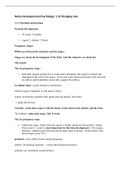Notes Developmental Psychology: 1.5C Changing man
1.5.1 The birds and the bees
Prenatal Development:
38 weeks/ 9 months
1. zygote 2. embryo 3. foetus
Pregnancy stages:
Difference between the trimester and the stages :
Stages are about the development of the baby. And the trimester are about the
The zygote:
The 1st pregnancy stage :
Germinal/ Zygote period, first 2 weeks after conception, the zygote is created and
implanted in the wall of the uterus . In the first week blastocysts (inner cells) turn into
an embryo and trophoblast (outer cells) support the embryo
Germinal Stage: zygote formed by fertilization
finished zygote implanted in wall uterus (7days)
zygote: developing organism after sperm and egg united ( 2nd week)
→ rapid cell division
Tendrils - stems that connect with the blood vessels between the mother and the fetus
The Embryo: embryonic stage: 2nd- 8 weeks
The 2st pregnancy stage
Embryonic stage . Starts when the zygote is firmly attached to the mother’s uterus.
From week 3 - week 8 ( most important for the fetus development ). The organs ,
placenta , umbilical cord develop and the heart starts to pulsate . Period where most
miscarriages occur 25%.
gestation: carry embryo/foetus during pregnancy
embryo: developing organism → major physiological structures
amniotic sac: membrane around embryo
,placenta: formed by cells → protect and sustain life
umbilical cord: tube contain blood vessel and connect growing baby and mother → oxygen
and nutrient and remove waste
When is a baby highest chance of survival : 42 weeks > after 52 weeks
Gender can be determined during three months
The first Trimester ( 1st and 2nd pregnancy stage )
highest miscarriage in first 6 weeks
detached wall uterus in first few weeks
The foetus: 3 month to delivery
The second trimester (3d pregnancy stage until birth)
The 3d pregnancy stage
The fetal stage. At the end of the 4th month all of the major organs and the sweat glands (5th
month) are developed . By the 6th month the baby can open its eyes. The stage of liability, if
the baby is born prematurely, it has a chance of survival.
bodily structures and systems
muscles and CNS
age of viability: 22-26 weeks able to survive- >physical systems advanced
Risks in prenatal environment:
teratogen: most threatening in embryonic stage
each organ different highest vulnerability
maternal and foetal genotypes affect response teratogen and determine abnormalities
An agent that potentially causes a birth effect.
Every fetus is exposed to a few of them.
Difficult to know .
,Teratogens cause the most problems in the embryonic stage
-different teratogens can produce same effect
the longer fetus exposed→ higher intensity and more likely harmed
Environmental dangers: (il)legal drugs:
aspirin→ low birth weight, lower IQ, poor motor control
smoking and drinking→ disturbance placental functioning
oxygen deprivation→ change foetus brain
passive smoke→ Higher risk variety of illness , delay intellectual
foetal alcohol syndrome: mental retardation , physiological abnormalities, 20% shorter,
abnorma behavior
men drink→ genetic damage
maternal cocaine→ physical and behavioral problems → brain hamerrohages. and neuron
damage, crying, depressed and unresponsive behavior
-depend on environment
mother addict→ child withdrawal symptoms → irritability and less able regulate arousal
Environmental toxins: automobile fumes water industrail waste → brain damage, low birth
weight
radiation, gases→ chromosomal abnormalities, lower fertility
aspirirn→ blood disorders
Radiation, Toxic waste - (mental retardation)
Characteristics of the mother:
The health of the fetus depends on the mothers diet, emotional states and age.
Age: first child over 35→ more complication→ Down syndrome and illness
teenage mother→ risky environment, neglect health and diet, use drug and higher risk
premature and low birth weight babies
fertility declines after 27
, diet: malnourishment→ miscarriage, low weight, physical and neural defects , smaller and
cognitive difficulties
Emotional state: stressed→ troubled pregnancies, miscarriage, delivery complication,
hyperactive, irritable, sleep and feeding problems
Characteristics of the Father:
Age: men less fertile and declining quality sperm
Diet: coffee and smoking→ negative impact sperm quality, Zinc pos.
The exposure to radiation of pesticides can influence his sperm and cause
Psychoactive drugs
Alter your nervous system
Most common effect on the embryo after the baby is born : Low birth weight,
miscarriages or stillbirth and blindness.
90% of all women are exposed to drugs during their pregnancy
Nicotine
Causes pretime and low eight births. Respiratory and cardiovascular problems. Also causes
ADHD.
Alcohol
(FAS) structural defects of the child (shorter head etc), low weight and mental retardation
(due to oxygen shortage )
Cocaine
Reduced birth weight. Lower reflexes and slower growth rate****
Heroin : Mothers that use opiates during pregnancy, the chance that the baby is born
withdrawal symptoms (tremors) is higher . Not sure if the effects are due to drugs. If the
mother stops using drugs before the fetal stage the baby is less affected
Caffeine
If a mother consumes to much (>200 mg) a day this can lead to a miscarriage.
Marijuana
Resulted in Lower IQ.
Antidepressants





